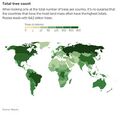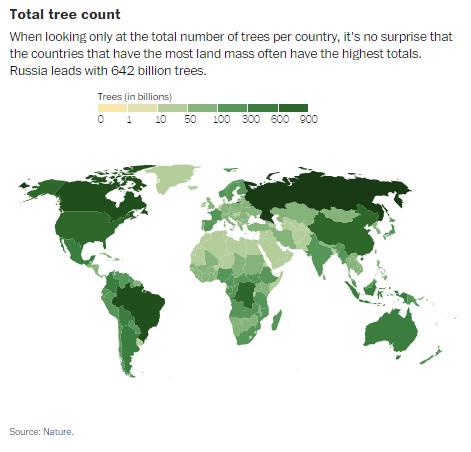File:Three trillion trees.jpg
Three_trillion_trees.jpg (471 × 452 pixels, file size: 26 KB, MIME type: image/jpeg)
Via Nature - Sept 2015
http://www.nature.com/nature/journal/v525/n7568/full/nature14967.html
The global extent and distribution of forest trees is central to our understanding of the terrestrial biosphere. We provide the first spatially continuous map of forest tree density at a global scale. This map reveals that the global number of trees is approximately 3.04 trillion, an order of magnitude higher than the previous estimate. Of these trees, approximately 1.39 trillion exist in tropical and subtropical forests, with 0.74 trillion in boreal regions and 0.61 trillion in temperate regions. Biome-level trends in tree density demonstrate the importance of climate and topography in controlling local tree densities at finer scales, as well as the overwhelming effect of humans across most of the world. Based on our projected tree densities, we estimate that over 15 billion trees are cut down each year, and the global number of trees has fallen by approximately 46% since the start of human civilization...
“Trees are among the most prominent and critical organisms on Earth, yet we are only recently beginning to comprehend their global extent and distribution,” said Thomas Crowther, a Yale Climate & Energy Institute postdoctoral fellow at the Yale School of Forestry & Environmental Studies (F&ES) and lead author of the study.
“They store huge amounts of carbon, are essential for the cycling of nutrients, for water and air quality, and for countless human services..."
“We’ve nearly halved the number of trees on the planet, and we’ve seen the impacts on climate and human health as a result,” Thomas Crowther of the Yale School of Forestry & Environmental Studies and lead author of the research said. “This study highlights how much more effort is needed if we are to restore healthy forests worldwide.”
http://www.nature.com/nature/journal/v525/n7568/fig_tab/nature14967_SF1.html
http://www.nature.com/nature/journal/v525/n7568/fig_tab/nature14967_SF2.html
http://www.nature.com/nature/journal/v525/n7568/fig_tab/nature14967_SF3.html
http://www.nature.com/nature/journal/v525/n7568/fig_tab/nature14967_SF4.html
http://www.nature.com/nature/journal/v525/n7568/fig_tab/nature14967_ST1.html
File history
Click on a date/time to view the file as it appeared at that time.
| Date/Time | Thumbnail | Dimensions | User | Comment | |
|---|---|---|---|---|---|
| current | 20:41, 16 September 2015 |  | 471 × 452 (26 KB) | Siterunner (talk | contribs) | Via Nature - Sept 2015 http://www.nature.com/nature/journal/v525/n7568/full/nature14967.html The global extent and distribution of forest trees is central to our understanding of the terrestrial biosphere. We provide the first spatially continuous ma... |
You cannot overwrite this file.
File usage
The following page uses this file:
